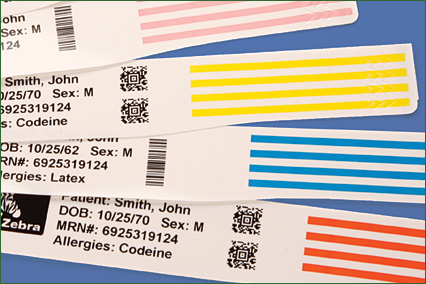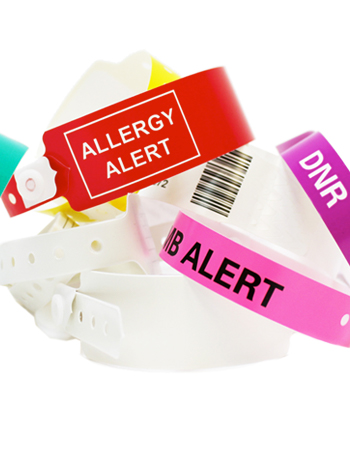Enhancing Safety And Security: The Value of Client Recognition Bands in Healthcare
In the world of healthcare, the effectiveness of patient identification bands can not be overstated, as they serve as a basic safeguard versus misidentification and succeeding errors. These bands, typically overlooked, include essential info that is crucial for ensuring individual safety and security and optimum treatment end results. However, the application of reliable recognition protocols presents numerous difficulties that health care providers should browse. As we discover the complex role of these bands, it becomes apparent that their significance prolongs past simple recognition, increasing inquiries concerning ideal techniques and future innovations in patient safety.
Summary of Person Identification Bands
Patient recognition bands play a vital role in ensuring the safety and precision of individual treatment in health care settings. These bands, usually used on the wrist or ankle joint, function as a crucial device for confirming client identity, thereby decreasing the danger of errors in therapy, medicine administration, and other health care treatments. Made from resilient products, person recognition bands usually consist of essential information such as the person's name, date of birth, clinical record number, and barcodes or QR codes for scanning.
The execution of patient identification bands is crucial in various medical care environments, consisting of medical facilities, outpatient centers, and long-lasting treatment institutions. They contribute to an organized technique in patient administration, allowing healthcare experts to swiftly and properly identify clients, specifically in high-pressure situations where quick decision-making is essential.
Additionally, using these bands is aligned with regulatory standards aimed at enhancing person safety and security - Patient Identification Band. By guaranteeing that each individual's information is conveniently obtainable and conveniently proven, medical care companies can maintain a high standard of care, minimize the occurrence of unfavorable occasions, and promote a culture of safety and security within medical care establishments
Benefits of Accurate Recognition
Accurate identification is essential to enhancing client security and care quality in healthcare setups. It offers as the initial line of protection against mistakes that might result in adverse patient end results. By making certain that each person is properly identified via trustworthy ways, such as client identification bands, doctor can significantly decrease the risk of misidentification, which can lead to unacceptable treatments, medication mistakes, and even medical mix-ups.
Furthermore, exact individual identification promotes efficient communication amongst medical care teams. When all team member can constantly identify individuals, they can share vital details a lot more efficiently, causing much better coordination of care. This is specifically essential in emergency situation scenarios where timely treatments are important.
In addition, accurate recognition supports compliance with governing standards, consequently reducing the threat of legal effects for medical care facilities. It cultivates trust between individuals and healthcare companies, as clients feel much more protected knowing that their identities are being guarded.

Usual Difficulties Encountered
Ensuring reliable individual identification in healthcare settings offers a variety of difficulties that can endanger security and care quality. One considerable obstacle is the variability in patient populations. Clients may arrive in a state of confusion or distress, making precise identification tough. Furthermore, language obstacles can prevent reliable communication, complicating the confirmation process.
Another obstacle is the reliance on human elements in recognition treatments. Healthcare experts might inadvertently misinterpret or forget identification protocols, especially in high-stress settings such as emergency situation divisions. This can lead to mistakes, including the management of wrong treatments or drugs.
Technical issues likewise pose difficulties. Although electronic health and wellness document (EHR) systems are created to streamline patient identification, system interruptions or customer mistakes can interrupt the procedure. The physical design of client ID bands can lead to readability problems, particularly in instances where bands are harmed or obscured.
Finally, irregular training amongst staff regarding recognition methods can result in voids in expertise and method. Attending to these challenges is important for enhancing patient safety and security and guaranteeing that identification bands offer their desired objective successfully.
Finest Practices for Application
To effectively execute individual identification bands in healthcare setups, organizations must adopt a multifaceted technique that prioritizes technology, training, and standardization assimilation. Standardization entails establishing clear protocols for the design, application, and usage of identification bands throughout all departments. This makes certain consistency and lessens the danger of mistakes linked to differences in band types or identifying techniques.


Training is crucial for all medical care team to ensure they understand the relevance of exact individual identification, how to effectively use and review recognition bands, and the procedures to adhere to in case of disparities. Routine workshops and refresher course programs can reinforce this expertise and advertise a culture of safety.
Innovation combination plays an essential role in boosting the effectiveness of client identification bands. Using barcode scanning or RFID modern technology can streamline the recognition procedure, enabling for real-time verification of individual identities. Additionally, electronic wellness document systems must be set up to consist of signals for mismatches in between the recognition band and client information.
Future Trends in Person Safety
As medical care remains to develop, the focus on person safety is likely to escalate, driven by improvements in modern technology and a greater understanding of systemic dangers. Arising trends check this show a change towards more integrated systems that take advantage of information analytics, fabricated knowledge, and machine discovering to improve individual recognition procedures. These modern technologies can help identify prospective security problems prior to they rise, thereby decreasing errors related to misidentification.
Additionally, the application of blockchain innovation might reinvent exactly how patient information is safely shared amongst doctor, making sure that recognition bands are constantly precise and up-to-date. This will not just enhance client safety but additionally promote seamless communication across multidisciplinary groups.

Furthermore, the expanding concentrate on personalized medicine is expected to influence individual safety and security protocols. By incorporating genetic and market details right into identification systems, healthcare professionals can tailor treatments a lot more successfully, decreasing the threats of unfavorable responses due to misidentification.
Final Thought
In final thought, person recognition bands serve as a vital element in boosting safety and security within health care atmospheres. Ultimately, the continued emphasis on durable identification see this protocols will contribute to improved person results and general safety and security in health care setups.
In the world of medical care, the efficiency of client identification bands can not be overemphasized, as they offer as an essential protect against Clicking Here misidentification and succeeding mistakes.Individual recognition bands play an important duty in making certain the security and precision of client treatment in health care setups. Made from resilient products, patient recognition bands often consist of essential info such as the person's name, date of birth, clinical record number, and barcodes or QR codes for scanning.
By making certain that each client is appropriately identified with reliable means, such as individual recognition bands, healthcare suppliers can significantly lessen the threat of misidentification, which can lead to unacceptable treatments, medicine mistakes, and also medical mix-ups.
In conclusion, client identification bands offer as an important component in enhancing security within health care settings. Patient Identification Band.